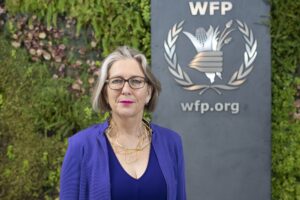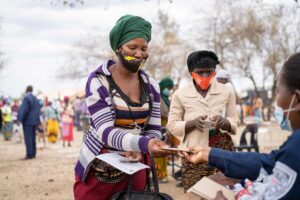The SMART Principles for Premium and Capital Support mark a new way to set up and approach support for vulnerable countries and communities, via climate and disaster risk finance. Ute Klamert, Assistant Executive Director at the World Food Programme, shares insights from the WFP’s work and how to implement the five principles for SMART premium and capital support.
Ms. Klamert, from your point of view, why is it of utmost importance for countries to discuss premium and capital support right now?
UK: As the climate crisis is accelerating, vulnerable population are at risk of suffering greater losses and damages to their livelihoods. As such, we at the World Food Programme are challenged with approaching donors with ever larger and more frequent requests to finance humanitarian response. And the reason for that is very simple: because climate stress factors are triggering an increase in humanitarian needs.
You can see this in the tropical cyclones and hurricanes that are threatening southern Africa or the Caribbean, and extreme droughts in Madagascar and the Sahel. With these increased demands on the humanitarian system, we have to find a solution, as there will never be enough funds available to address the needs of every crisis. So, while continuing to save lives, we must shift towards protecting lives before they need saving. And our working assumption is that risk financing instruments, and in particular insurance, can help to get us there.

Ms. Ute Klamert
Assistant Executive Director, World Food Program
Photo: WFP/Rein Skullerud
What kind of understanding does the WFP share for climate and disaster risk finance as means to lessen the impact of climate change to vulnerable communities?
UK: To quote our colleagues from the private sector, losses in global insurance and reinsurance markets from natural hazards and severe weather events, in this year 2021, are running at double the long-term average at nearly 90 billion US dollars, the highest level seen since 2017. At WFP, we have recognised insurance premiums as a transfer modality since 2013, which means that insurance premiums are considered part of WFP’s diverse solutions to prevent hunger along with food distributions, cash and vouchers. And that is also our vision. We have to use the insurance premiums as a mode of delivery in our context. To give you an example figure, WFP is using cash-based transfers in its operations that average a total 2.2 billion US dollars per year. Just imagine if some of this cash support was delivered through the insurance market, which would allow for WFP to make more efficient use of limited resources. In this regard, we see the adoption of the Policy Note as a significant step forward.
Looking at the InsuResilience SMART principles as guidelines to set up future premium and capital support, how do you anticipate the principles to be implemented? Could you share some examples?
UK: We already see results of how premium support systems based on the SMART Principles are working at scale:
- Starting with the S, for Sustainable Impact for the most vulnerable. We have tested a co-financing model in Senegal, and the model is very simple: we pay premium directly to the insurer when participants, the beneficiaries, engage in activities such as soil and water conservation. And, taking the example of Senegal, 40% of the premium – 6 US dollars – is currently paid by every participant, and the government of Senegal is subsidising half of the total premium – 14 US dollars –, insuring sufficient coverage in drought-prone regions. This is an example for a very simple, straightforward co-financing model to support the most vulnerable.
- M, Value for Money. Premium support for insurance can provide resources to scale up responses in areas with high vulnerability and frequent, localised shocks. For example, in Madagascar, the entire island was not exposed to the same level of drought. Particularly in the south, we had a very localised shock. With a US$ 70,000 premium paid by WFP, a total of US$ 350,000 was paid out to highly food insecure communities. With each household receiving US$100, these payouts were equivalent to five months of cash transfers that a family would typically receive from humanitarian responses in the region. So, even though the amount might sound small in terms of trigger-payout, it makes a huge difference for the people who are at the brink of starvation in south Madagascar. A very proven and convincing model for WFP.
- On to A, Accessibility. Accessibility means understanding the target population and ensuring that the insurance market meets the needs of our beneficiaries. Close engagement with the insurance industry and technical service providers is essential to ensure that these products are affordable for vulnerable households if subsidies are phased out. Because one could offer a whole range of new products, but if they are not affordable, one is not meeting the demands.

In 2021, the insurance pay-out will benefit more than 57,000 farmers across the districts of Balaka, Blantyre, Chikwawa, Machinga, Mangochi, Nsanje, Phalombe in Malawi. Photo: WFP/ Badre Bahaji.
- On to R, Resilience Building initiatives. WFP’s approach to insurance focuses on SDG2, Zero Hunger, and if I look at our entire portfolio, we can say that insurance payouts have really proven their benefits. This is coming back to our vision that insurance has the potential to scale up to the level of our cash-based transfers, vouchers or food distribution. Two examples: going back to our example in Senegal, access to insurance has strengthened food security and resilience to droughts compared with non-insured households. After a drought, insured households food consumption dropped only 8% compared with 44% of non-insured households. And in Ethiopia, integrating insurance with risk reduction and financial services has helped double household savings and increased loans received by 400%, which in return has boosted the investment capacities of local farmers.
- T, for Transparency and Consistency. Maybe we are very ambitious, but by providing temporary subsidies, we really want to create a space for experimentation and capacity development in which the insurance industry can help develop products for a market segment which might not be the easiest to serve, let me put it that way. So that is definitely also our wish. Also, we are supporting coinsurance pools when possible, to create conditions where insurers work together to increase local retention, reduce competition when the market is nascent, and possibly pool investments to set up viable markets. In under-developed markets, WFP has favoured the establishment of co-insurance pools such as in Ethiopia and works with existing ones in Kenya or Malawi.
Beyond the SMART premium and capital support principles, what more is needed? And, in your opinion, what should be the way forward for Climate and Disaster Risk finance?
UK: Moving away from the five Principles, in Malawi, 325,000 beneficiaries are currently receiving payouts totalling 2.45 million US dollars, which is one of the largest microinsurance payouts ever recorded in Africa. This is our success story. We already see the first proof that we can talk about scaling effects in some of the countries that we are engaged with. And I want to conclude that our hope is that these models of scaling up like in Malawi, but also all the others I have shared, will bring us much closer to reaching an ambitious goal, and the SMART Principles will provide the right framing for achieving our ambitions. Having said that, I am very proud of all these examples and I hope that we will see and read more implementation examples of these principles.
We thank you for the interview, Ms. Ute Klamert.
